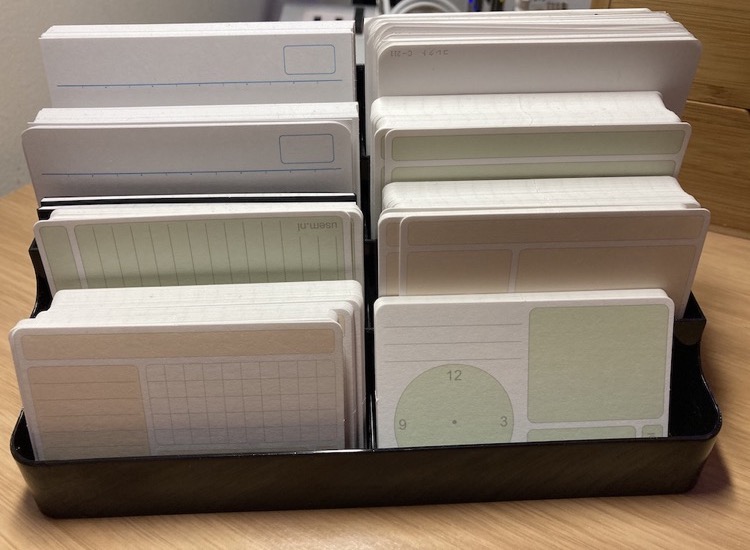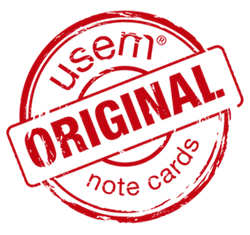Behoren de usem-kaartjes tot de essentiële schrijversbenodigdheden? Bij de Britse schrijfster Karen Traviss staat in ieder geval een bakje met usem-kaartjes naast de computer. “I was smitten by them and bought a big stash” schrijft de New York Times bestselling author in haar blogpost ‘Essential kit for writers‘.
Hoofdregel: iedere schrijver moet vooral gebruiken wat voor hem of haar het beste werkt. “People have written with needles on bars of soap in prison, and on paper bags with stubs of pencil when in extreme poverty, so lack of fancy equipment is no excuse for not writing. But it’s a very individual thing, and all I can tell you is what works for me.”
Karen Traviss zweert bij:
Een computer
Lijkt misschien logisch, maar er zijn nog altijd schrijvers die met de hand schrijven of op een typemachine werken.
Een mechanisch toetsenbord
Ik moest ‘t opzoeken, maar weet nu dat ‘r twee soorten toetsenborden zijn: mechanische en met membraantoetsen. Mechanische toetsenborden reageren lekker snel en voor Karen Traviss was het dé oplossing om als snelschrijver van de vele typo’s af te komen. Ook populair onder gamers.
Een groot scherm
Vooral handig bij het redigeren. Ze gebruikt een 27 inch scherm, maar denkt geregeld: had best een slagje groter gemogen.
Een woordenboek
En ze zegt daar snel achteraan: dus niet een spelling checker! Een echt boek, met woorden en uitleg, mag ook digitaal zijn. Een spelling checker maakt lui en je leert er niks van.
Efficient papieren systeem
En toen gingen we rechtop zitten. You need to make notes when ideas strike you. En je moet die notes later ook gemakkelijk weer terug kunnen vinden. Karen Traviss gebruikt hiervoor pen en papier, wat ze altijd bij de hand heeft. Having something to hand everywhere is essential because by the time you find a pen and paper, you’ll have forgotten what you were thinking.
Scrivener
Ze is een groot fan van Scrivener, wil ‘r zelfs mee begraven worden (wat nog niet zo eenvoudig is, aangezien ‘t hier om software gaat.)
A change of wall
Karen Traviss bedoelt hiermee: verander eens van omgeving of werkwijze. Een nieuw uitzicht prikkelt hersengebieden die anders liggen te slapen. Draai je bureau dus eens of verf de muur waar je tegenaan kijkt. Of ga in een kroeg zitten. Net wat voor jou werkt.
Planning cards are hard to beat
En dan komt de update van september 2020. Die gaan we niet vertalen of samenvatten; ieder woord is ons even dierbaar.
For the analogue folks among us who like pen and pencil work, planning cards are hard to beat. You can plan your scenes out in advance, if that’s how you write, or summarise the scenes you’ve already written, or keep character sheets, and all kinds of stuff. That’s what Scrivener is mimicking in digital form, of course. So I discovered some stunning cards thanks to a stationery mailing list I’m on. (Yes, you can laugh. But stationery nerding is a holy thing.)

These cards from Usem, a small Dutch company, are credit card size, and come in different layouts. You can use them for pretty much any purpose your imagination can stretch to. They’re excellent quality, fountain pen friendly, and the guy who runs the company is friendly and helpful too. I was smitten by them and bought a big stash. The beauty of them for writers is their size –– they’re small, so you can arrange them to see them all at a glance a lot more easily than 3 x 5s, and you can store and display them in credit card or business card holders. That means folders, small cases, stands… anything that suits the way you work. I like to have stuff propped up in front of me to refer to while I type, so these business card “bleachers” are perfect for me. (The all-white cards in the image are Japanese brands, Kokuyo and Correct. Same size, more or less, but lighter weight stock, and the overprinting on the Usem cards makes a surprising difference to focusing my thoughts.)
We zijn er stil van.
